The Neurobiological Impact of Job Burnout in the Healthcare Sector
VerifiedAdded on 2022/08/31
|12
|2009
|34
Report
AI Summary
This report presents a systematic review of the neurobiological factors associated with job burnout in the healthcare sector. The study examines how work-related stress, emotional and physical exhaustion, and work-life imbalances affect healthcare professionals. It explores the role of the limbic system, neurotransmitters, and other brain structures in the development of burnout, including the impact on cognitive and emotional functions. The methodology includes a search of electronic databases like PubMed, CINAHL, and SCIENCEDIRECT, with inclusion criteria focusing on peer-reviewed, English-language articles published within the last five years. The findings highlight the dysfunctions in brain mechanisms related to attention, memory, and neurotransmitter levels, and also the activation of the hypothalamus-pituitary-adrenal axis, leading to stress responses. The critical analysis discusses the limitations of the reviewed studies, such as sample size and methodological issues, while acknowledging the importance of the findings regarding structural and functional brain changes in burnout. The report concludes by emphasizing the need for further research, particularly in the context of understanding the amygdala's role in the burnout process. The report uses multiple research papers and articles to support the findings and analysis.
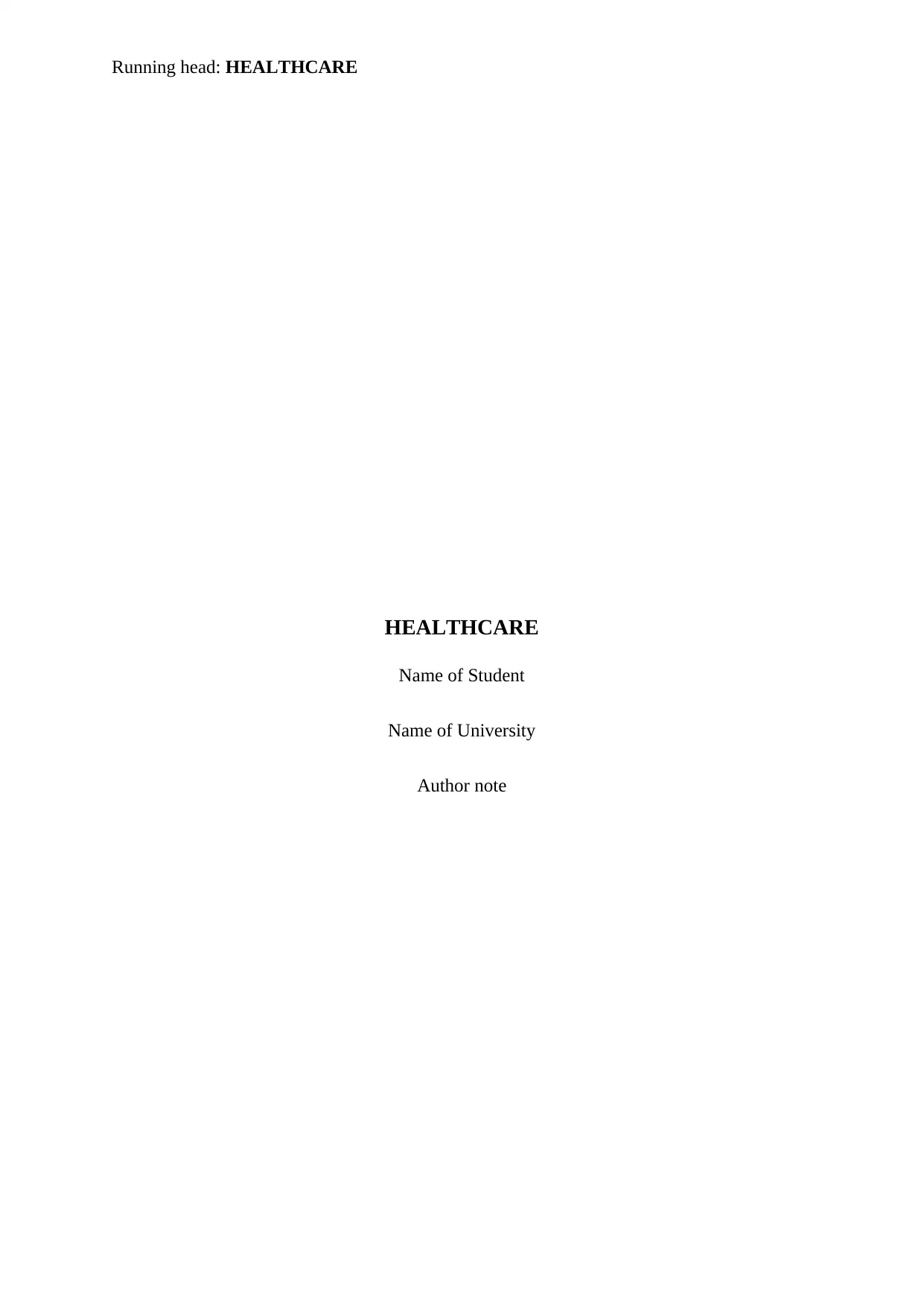
Running head: HEALTHCARE
HEALTHCARE
Name of Student
Name of University
Author note
HEALTHCARE
Name of Student
Name of University
Author note
Paraphrase This Document
Need a fresh take? Get an instant paraphrase of this document with our AI Paraphraser
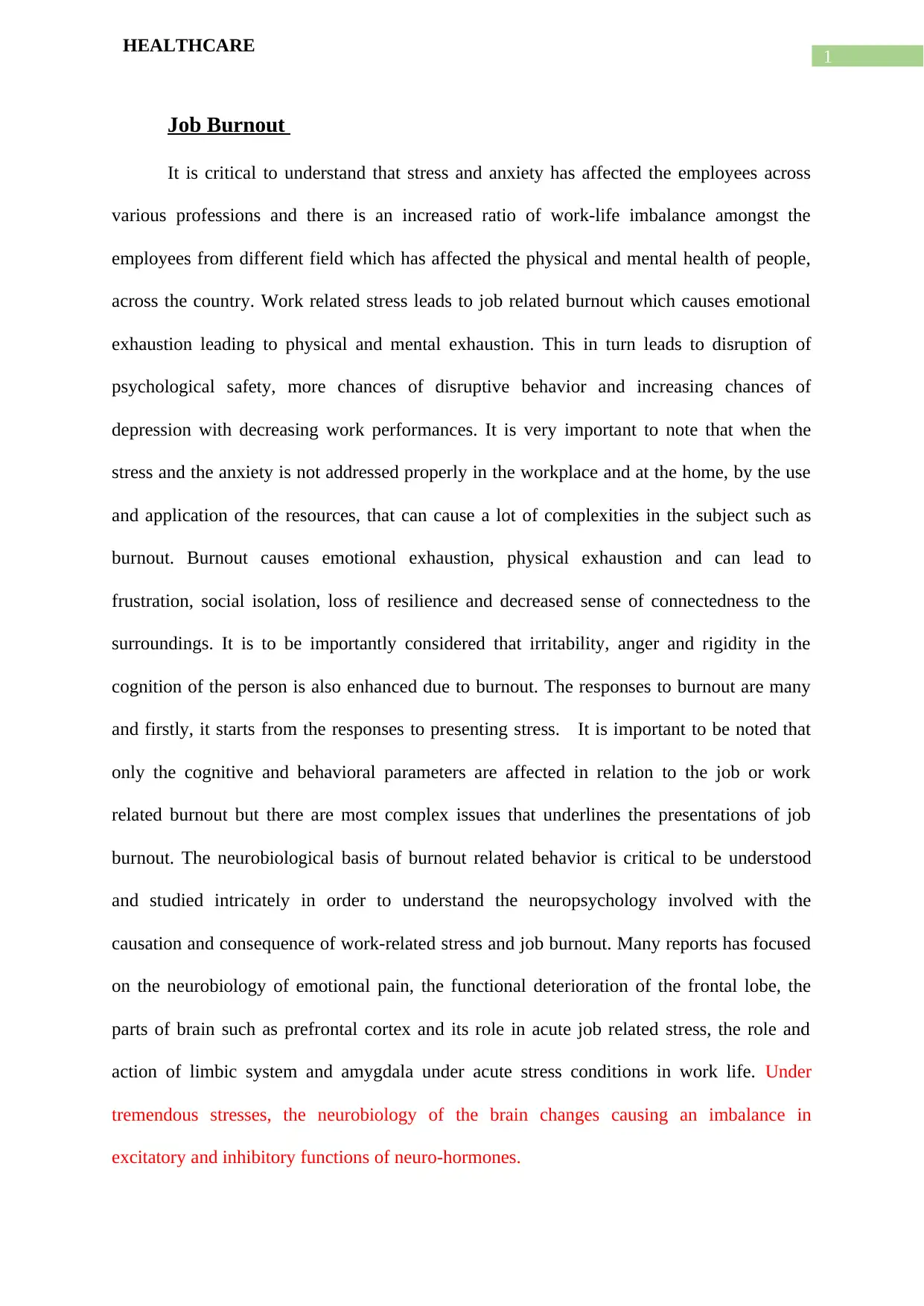
1
HEALTHCARE
Job Burnout
It is critical to understand that stress and anxiety has affected the employees across
various professions and there is an increased ratio of work-life imbalance amongst the
employees from different field which has affected the physical and mental health of people,
across the country. Work related stress leads to job related burnout which causes emotional
exhaustion leading to physical and mental exhaustion. This in turn leads to disruption of
psychological safety, more chances of disruptive behavior and increasing chances of
depression with decreasing work performances. It is very important to note that when the
stress and the anxiety is not addressed properly in the workplace and at the home, by the use
and application of the resources, that can cause a lot of complexities in the subject such as
burnout. Burnout causes emotional exhaustion, physical exhaustion and can lead to
frustration, social isolation, loss of resilience and decreased sense of connectedness to the
surroundings. It is to be importantly considered that irritability, anger and rigidity in the
cognition of the person is also enhanced due to burnout. The responses to burnout are many
and firstly, it starts from the responses to presenting stress. It is important to be noted that
only the cognitive and behavioral parameters are affected in relation to the job or work
related burnout but there are most complex issues that underlines the presentations of job
burnout. The neurobiological basis of burnout related behavior is critical to be understood
and studied intricately in order to understand the neuropsychology involved with the
causation and consequence of work-related stress and job burnout. Many reports has focused
on the neurobiology of emotional pain, the functional deterioration of the frontal lobe, the
parts of brain such as prefrontal cortex and its role in acute job related stress, the role and
action of limbic system and amygdala under acute stress conditions in work life. Under
tremendous stresses, the neurobiology of the brain changes causing an imbalance in
excitatory and inhibitory functions of neuro-hormones.
HEALTHCARE
Job Burnout
It is critical to understand that stress and anxiety has affected the employees across
various professions and there is an increased ratio of work-life imbalance amongst the
employees from different field which has affected the physical and mental health of people,
across the country. Work related stress leads to job related burnout which causes emotional
exhaustion leading to physical and mental exhaustion. This in turn leads to disruption of
psychological safety, more chances of disruptive behavior and increasing chances of
depression with decreasing work performances. It is very important to note that when the
stress and the anxiety is not addressed properly in the workplace and at the home, by the use
and application of the resources, that can cause a lot of complexities in the subject such as
burnout. Burnout causes emotional exhaustion, physical exhaustion and can lead to
frustration, social isolation, loss of resilience and decreased sense of connectedness to the
surroundings. It is to be importantly considered that irritability, anger and rigidity in the
cognition of the person is also enhanced due to burnout. The responses to burnout are many
and firstly, it starts from the responses to presenting stress. It is important to be noted that
only the cognitive and behavioral parameters are affected in relation to the job or work
related burnout but there are most complex issues that underlines the presentations of job
burnout. The neurobiological basis of burnout related behavior is critical to be understood
and studied intricately in order to understand the neuropsychology involved with the
causation and consequence of work-related stress and job burnout. Many reports has focused
on the neurobiology of emotional pain, the functional deterioration of the frontal lobe, the
parts of brain such as prefrontal cortex and its role in acute job related stress, the role and
action of limbic system and amygdala under acute stress conditions in work life. Under
tremendous stresses, the neurobiology of the brain changes causing an imbalance in
excitatory and inhibitory functions of neuro-hormones.
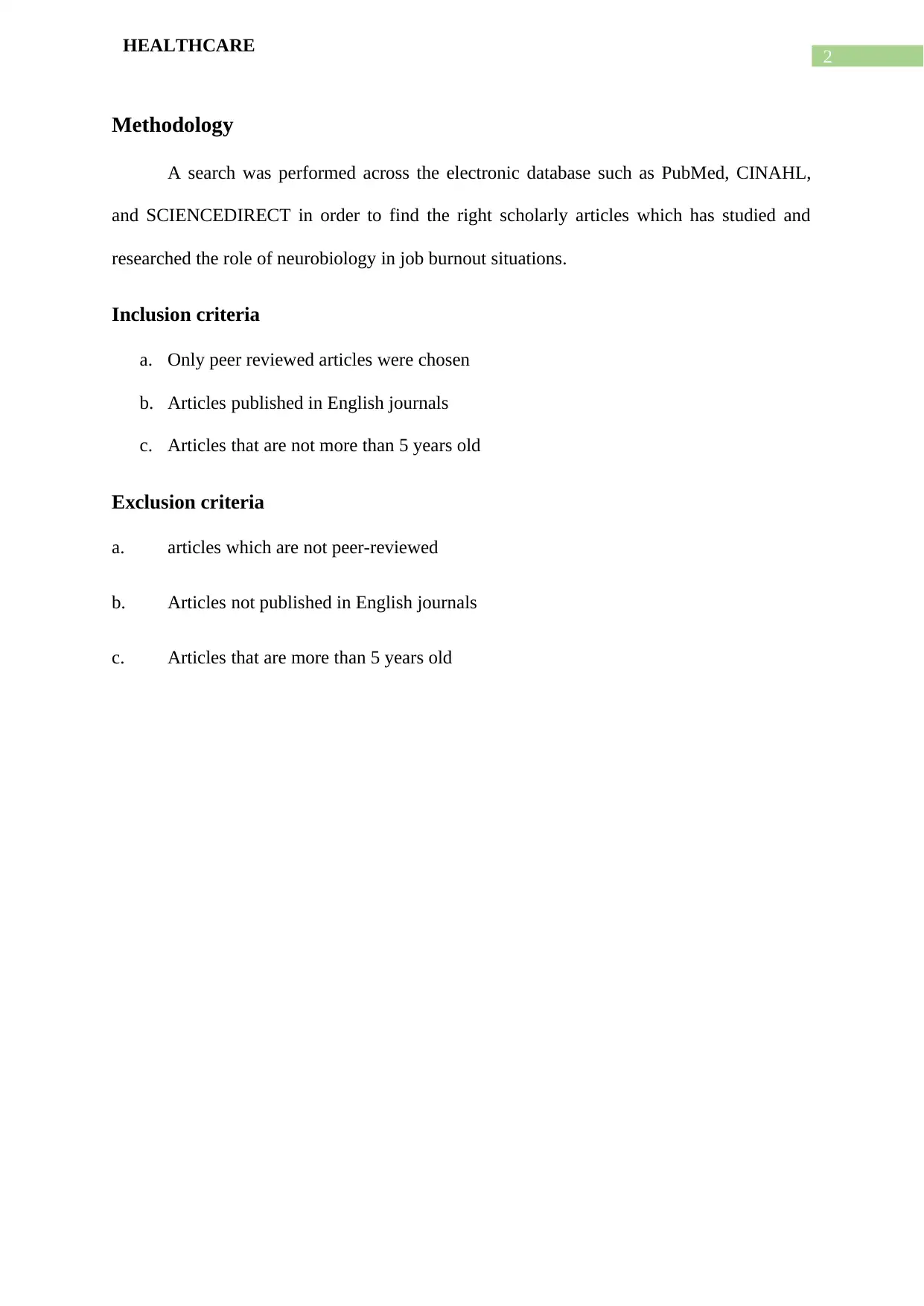
2
HEALTHCARE
Methodology
A search was performed across the electronic database such as PubMed, CINAHL,
and SCIENCEDIRECT in order to find the right scholarly articles which has studied and
researched the role of neurobiology in job burnout situations.
Inclusion criteria
a. Only peer reviewed articles were chosen
b. Articles published in English journals
c. Articles that are not more than 5 years old
Exclusion criteria
a. articles which are not peer-reviewed
b. Articles not published in English journals
c. Articles that are more than 5 years old
HEALTHCARE
Methodology
A search was performed across the electronic database such as PubMed, CINAHL,
and SCIENCEDIRECT in order to find the right scholarly articles which has studied and
researched the role of neurobiology in job burnout situations.
Inclusion criteria
a. Only peer reviewed articles were chosen
b. Articles published in English journals
c. Articles that are not more than 5 years old
Exclusion criteria
a. articles which are not peer-reviewed
b. Articles not published in English journals
c. Articles that are more than 5 years old
⊘ This is a preview!⊘
Do you want full access?
Subscribe today to unlock all pages.

Trusted by 1+ million students worldwide

3
HEALTHCARE
Systematic review
HEALTHCARE
Systematic review
Paraphrase This Document
Need a fresh take? Get an instant paraphrase of this document with our AI Paraphraser
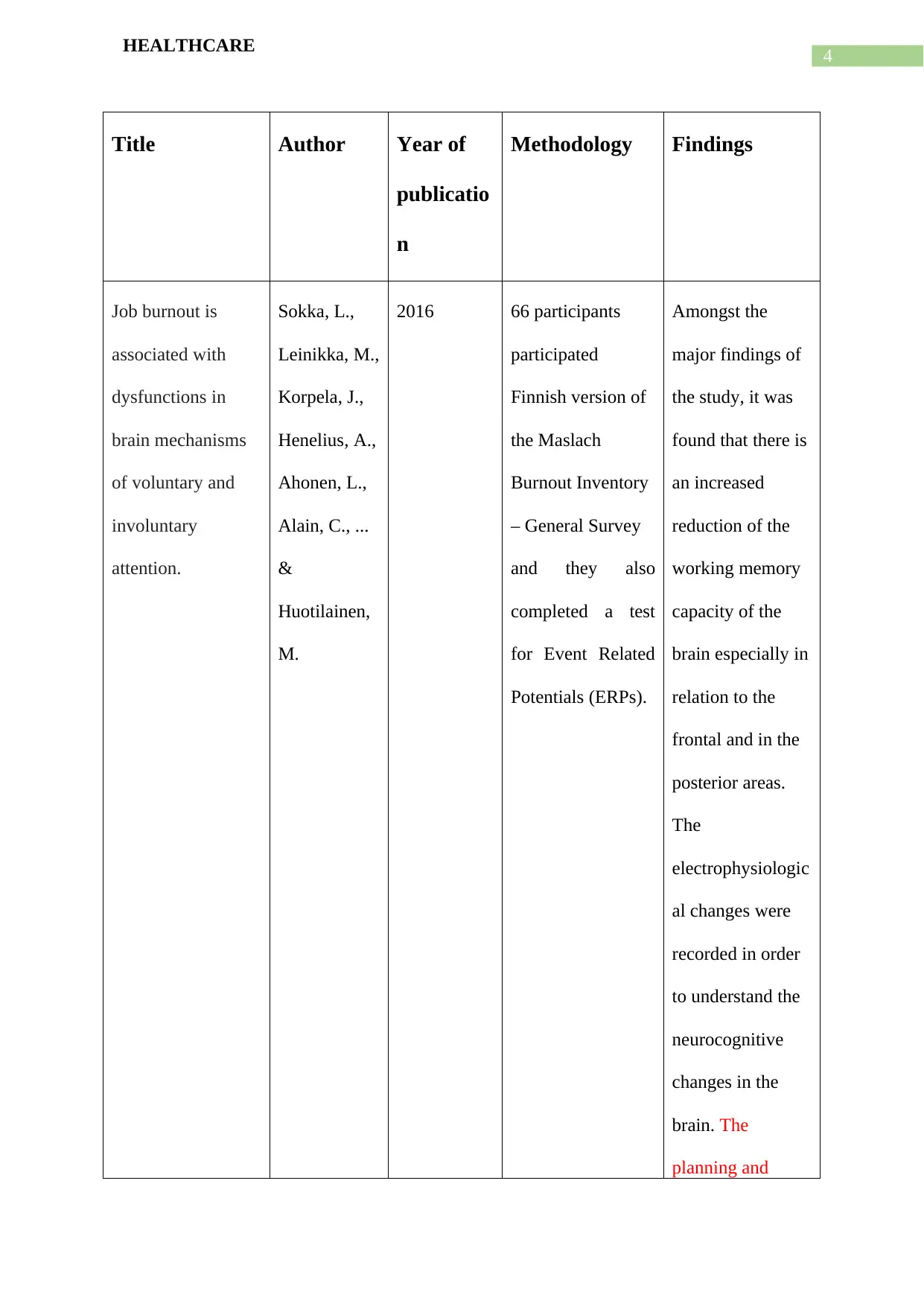
4
HEALTHCARE
Title Author Year of
publicatio
n
Methodology Findings
Job burnout is
associated with
dysfunctions in
brain mechanisms
of voluntary and
involuntary
attention.
Sokka, L.,
Leinikka, M.,
Korpela, J.,
Henelius, A.,
Ahonen, L.,
Alain, C., ...
&
Huotilainen,
M.
2016 66 participants
participated
Finnish version of
the Maslach
Burnout Inventory
– General Survey
and they also
completed a test
for Event Related
Potentials (ERPs).
Amongst the
major findings of
the study, it was
found that there is
an increased
reduction of the
working memory
capacity of the
brain especially in
relation to the
frontal and in the
posterior areas.
The
electrophysiologic
al changes were
recorded in order
to understand the
neurocognitive
changes in the
brain. The
planning and
HEALTHCARE
Title Author Year of
publicatio
n
Methodology Findings
Job burnout is
associated with
dysfunctions in
brain mechanisms
of voluntary and
involuntary
attention.
Sokka, L.,
Leinikka, M.,
Korpela, J.,
Henelius, A.,
Ahonen, L.,
Alain, C., ...
&
Huotilainen,
M.
2016 66 participants
participated
Finnish version of
the Maslach
Burnout Inventory
– General Survey
and they also
completed a test
for Event Related
Potentials (ERPs).
Amongst the
major findings of
the study, it was
found that there is
an increased
reduction of the
working memory
capacity of the
brain especially in
relation to the
frontal and in the
posterior areas.
The
electrophysiologic
al changes were
recorded in order
to understand the
neurocognitive
changes in the
brain. The
planning and

5
HEALTHCARE
execution of
motor functions
are affected.
HEALTHCARE
execution of
motor functions
are affected.
⊘ This is a preview!⊘
Do you want full access?
Subscribe today to unlock all pages.

Trusted by 1+ million students worldwide
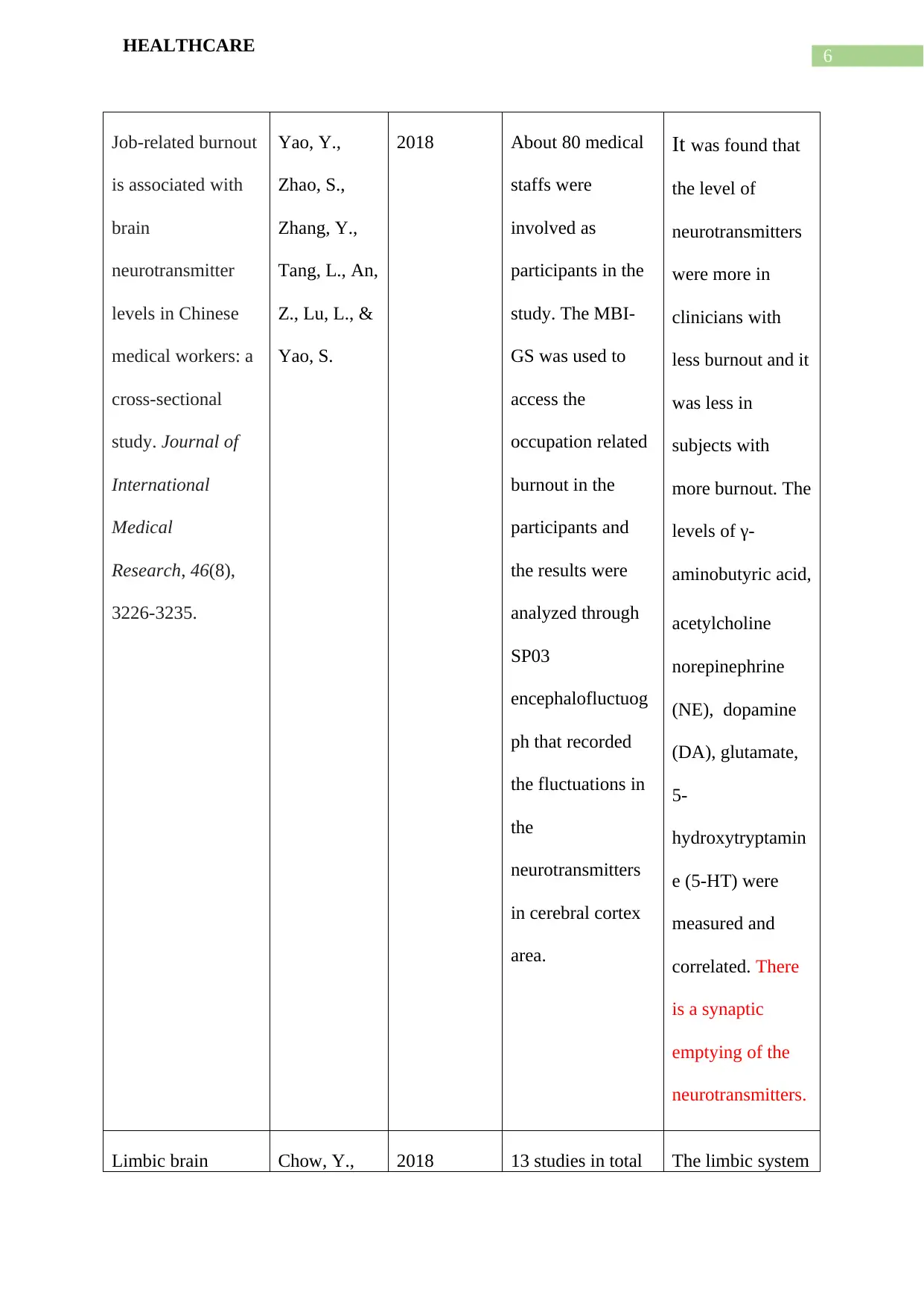
6
HEALTHCARE
Job-related burnout
is associated with
brain
neurotransmitter
levels in Chinese
medical workers: a
cross-sectional
study. Journal of
International
Medical
Research, 46(8),
3226-3235.
Yao, Y.,
Zhao, S.,
Zhang, Y.,
Tang, L., An,
Z., Lu, L., &
Yao, S.
2018 About 80 medical
staffs were
involved as
participants in the
study. The MBI-
GS was used to
access the
occupation related
burnout in the
participants and
the results were
analyzed through
SP03
encephalofluctuog
ph that recorded
the fluctuations in
the
neurotransmitters
in cerebral cortex
area.
It was found that
the level of
neurotransmitters
were more in
clinicians with
less burnout and it
was less in
subjects with
more burnout. The
levels of γ-
aminobutyric acid,
acetylcholine
norepinephrine
(NE), dopamine
(DA), glutamate,
5-
hydroxytryptamin
e (5-HT) were
measured and
correlated. There
is a synaptic
emptying of the
neurotransmitters.
Limbic brain Chow, Y., 2018 13 studies in total The limbic system
HEALTHCARE
Job-related burnout
is associated with
brain
neurotransmitter
levels in Chinese
medical workers: a
cross-sectional
study. Journal of
International
Medical
Research, 46(8),
3226-3235.
Yao, Y.,
Zhao, S.,
Zhang, Y.,
Tang, L., An,
Z., Lu, L., &
Yao, S.
2018 About 80 medical
staffs were
involved as
participants in the
study. The MBI-
GS was used to
access the
occupation related
burnout in the
participants and
the results were
analyzed through
SP03
encephalofluctuog
ph that recorded
the fluctuations in
the
neurotransmitters
in cerebral cortex
area.
It was found that
the level of
neurotransmitters
were more in
clinicians with
less burnout and it
was less in
subjects with
more burnout. The
levels of γ-
aminobutyric acid,
acetylcholine
norepinephrine
(NE), dopamine
(DA), glutamate,
5-
hydroxytryptamin
e (5-HT) were
measured and
correlated. There
is a synaptic
emptying of the
neurotransmitters.
Limbic brain Chow, Y., 2018 13 studies in total The limbic system
Paraphrase This Document
Need a fresh take? Get an instant paraphrase of this document with our AI Paraphraser
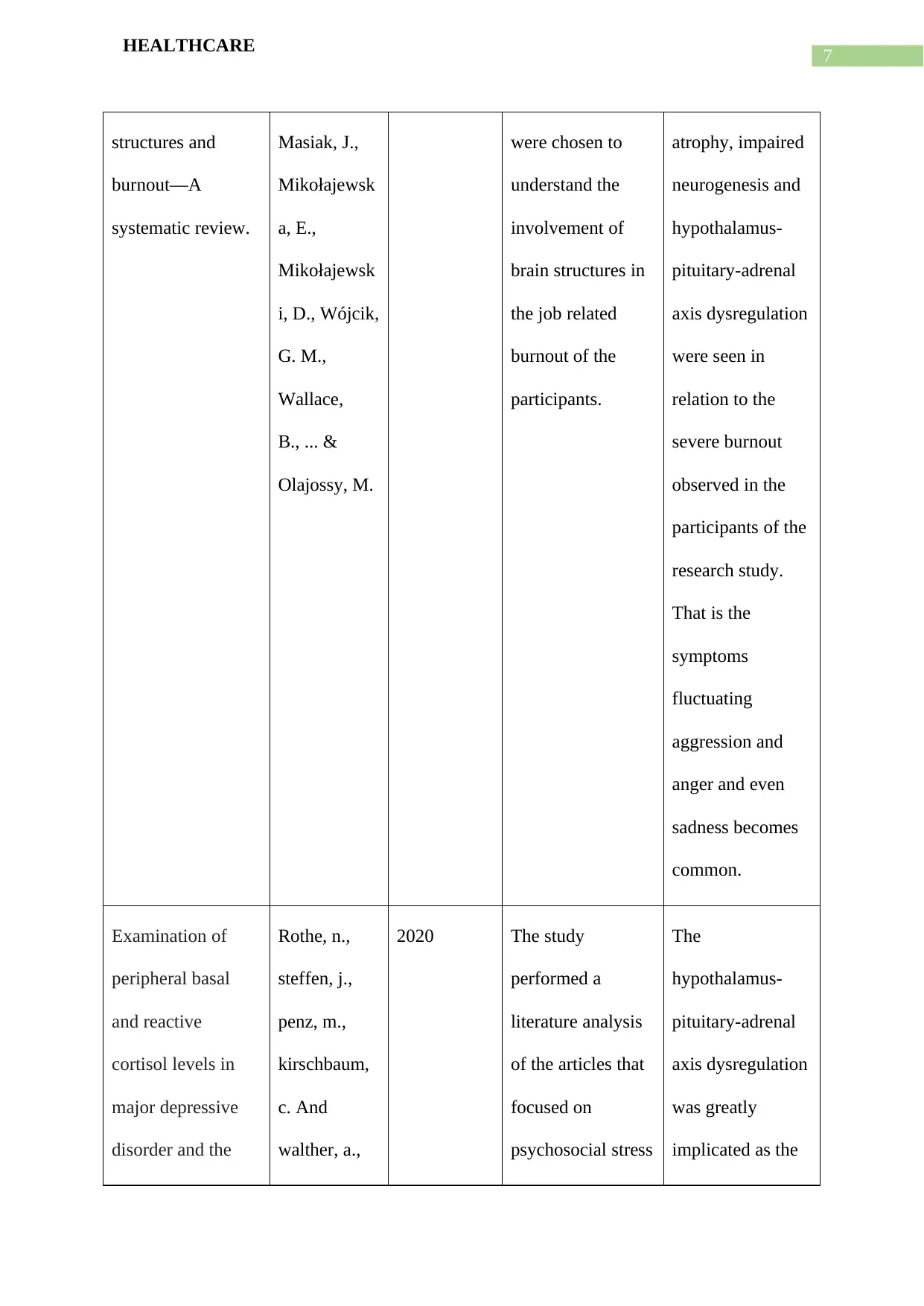
7
HEALTHCARE
structures and
burnout—A
systematic review.
Masiak, J.,
Mikołajewsk
a, E.,
Mikołajewsk
i, D., Wójcik,
G. M.,
Wallace,
B., ... &
Olajossy, M.
were chosen to
understand the
involvement of
brain structures in
the job related
burnout of the
participants.
atrophy, impaired
neurogenesis and
hypothalamus-
pituitary-adrenal
axis dysregulation
were seen in
relation to the
severe burnout
observed in the
participants of the
research study.
That is the
symptoms
fluctuating
aggression and
anger and even
sadness becomes
common.
Examination of
peripheral basal
and reactive
cortisol levels in
major depressive
disorder and the
Rothe, n.,
steffen, j.,
penz, m.,
kirschbaum,
c. And
walther, a.,
2020 The study
performed a
literature analysis
of the articles that
focused on
psychosocial stress
The
hypothalamus-
pituitary-adrenal
axis dysregulation
was greatly
implicated as the
HEALTHCARE
structures and
burnout—A
systematic review.
Masiak, J.,
Mikołajewsk
a, E.,
Mikołajewsk
i, D., Wójcik,
G. M.,
Wallace,
B., ... &
Olajossy, M.
were chosen to
understand the
involvement of
brain structures in
the job related
burnout of the
participants.
atrophy, impaired
neurogenesis and
hypothalamus-
pituitary-adrenal
axis dysregulation
were seen in
relation to the
severe burnout
observed in the
participants of the
research study.
That is the
symptoms
fluctuating
aggression and
anger and even
sadness becomes
common.
Examination of
peripheral basal
and reactive
cortisol levels in
major depressive
disorder and the
Rothe, n.,
steffen, j.,
penz, m.,
kirschbaum,
c. And
walther, a.,
2020 The study
performed a
literature analysis
of the articles that
focused on
psychosocial stress
The
hypothalamus-
pituitary-adrenal
axis dysregulation
was greatly
implicated as the
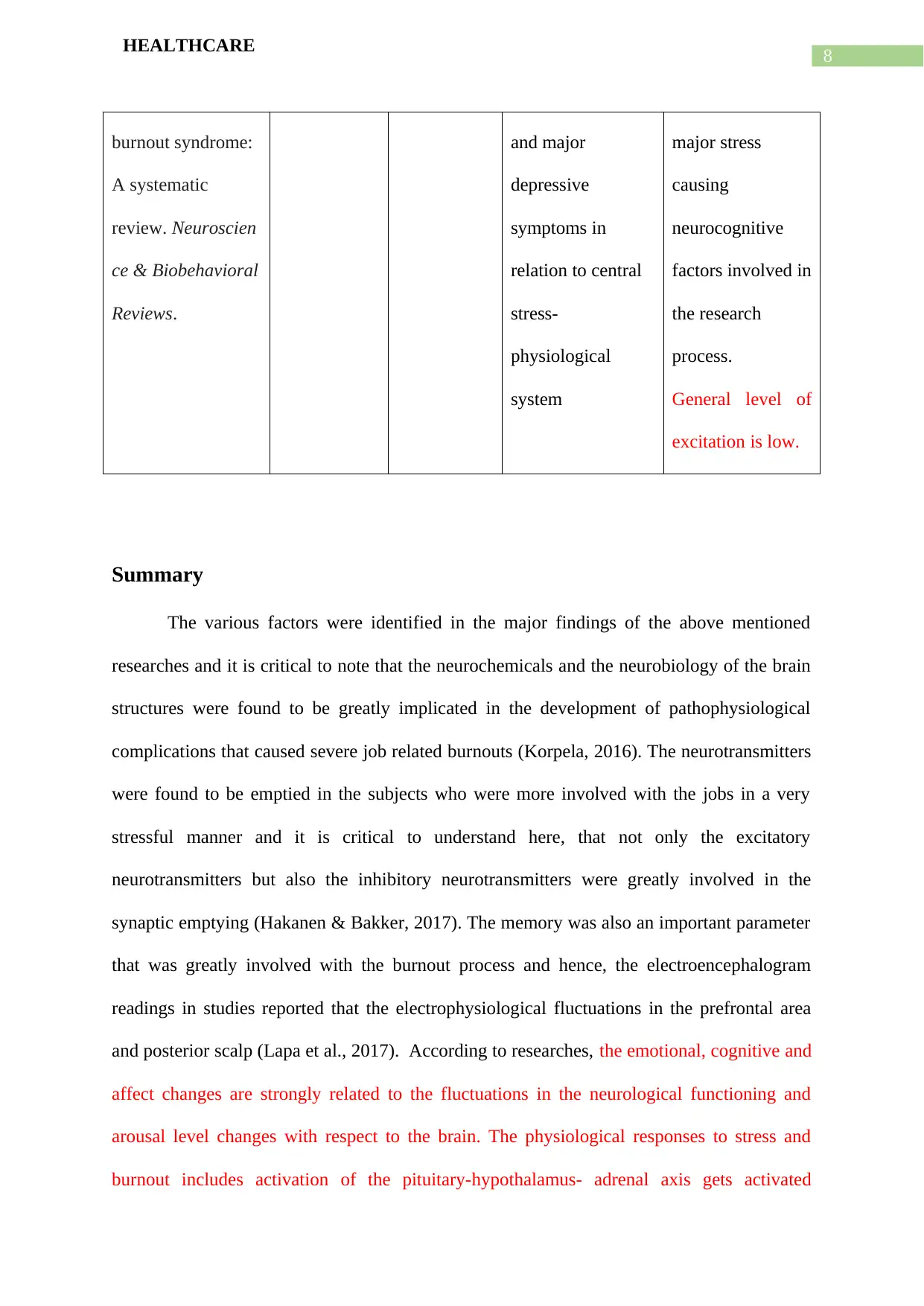
8
HEALTHCARE
burnout syndrome:
A systematic
review. Neuroscien
ce & Biobehavioral
Reviews.
and major
depressive
symptoms in
relation to central
stress-
physiological
system
major stress
causing
neurocognitive
factors involved in
the research
process.
General level of
excitation is low.
Summary
The various factors were identified in the major findings of the above mentioned
researches and it is critical to note that the neurochemicals and the neurobiology of the brain
structures were found to be greatly implicated in the development of pathophysiological
complications that caused severe job related burnouts (Korpela, 2016). The neurotransmitters
were found to be emptied in the subjects who were more involved with the jobs in a very
stressful manner and it is critical to understand here, that not only the excitatory
neurotransmitters but also the inhibitory neurotransmitters were greatly involved in the
synaptic emptying (Hakanen & Bakker, 2017). The memory was also an important parameter
that was greatly involved with the burnout process and hence, the electroencephalogram
readings in studies reported that the electrophysiological fluctuations in the prefrontal area
and posterior scalp (Lapa et al., 2017). According to researches, the emotional, cognitive and
affect changes are strongly related to the fluctuations in the neurological functioning and
arousal level changes with respect to the brain. The physiological responses to stress and
burnout includes activation of the pituitary-hypothalamus- adrenal axis gets activated
HEALTHCARE
burnout syndrome:
A systematic
review. Neuroscien
ce & Biobehavioral
Reviews.
and major
depressive
symptoms in
relation to central
stress-
physiological
system
major stress
causing
neurocognitive
factors involved in
the research
process.
General level of
excitation is low.
Summary
The various factors were identified in the major findings of the above mentioned
researches and it is critical to note that the neurochemicals and the neurobiology of the brain
structures were found to be greatly implicated in the development of pathophysiological
complications that caused severe job related burnouts (Korpela, 2016). The neurotransmitters
were found to be emptied in the subjects who were more involved with the jobs in a very
stressful manner and it is critical to understand here, that not only the excitatory
neurotransmitters but also the inhibitory neurotransmitters were greatly involved in the
synaptic emptying (Hakanen & Bakker, 2017). The memory was also an important parameter
that was greatly involved with the burnout process and hence, the electroencephalogram
readings in studies reported that the electrophysiological fluctuations in the prefrontal area
and posterior scalp (Lapa et al., 2017). According to researches, the emotional, cognitive and
affect changes are strongly related to the fluctuations in the neurological functioning and
arousal level changes with respect to the brain. The physiological responses to stress and
burnout includes activation of the pituitary-hypothalamus- adrenal axis gets activated
⊘ This is a preview!⊘
Do you want full access?
Subscribe today to unlock all pages.

Trusted by 1+ million students worldwide
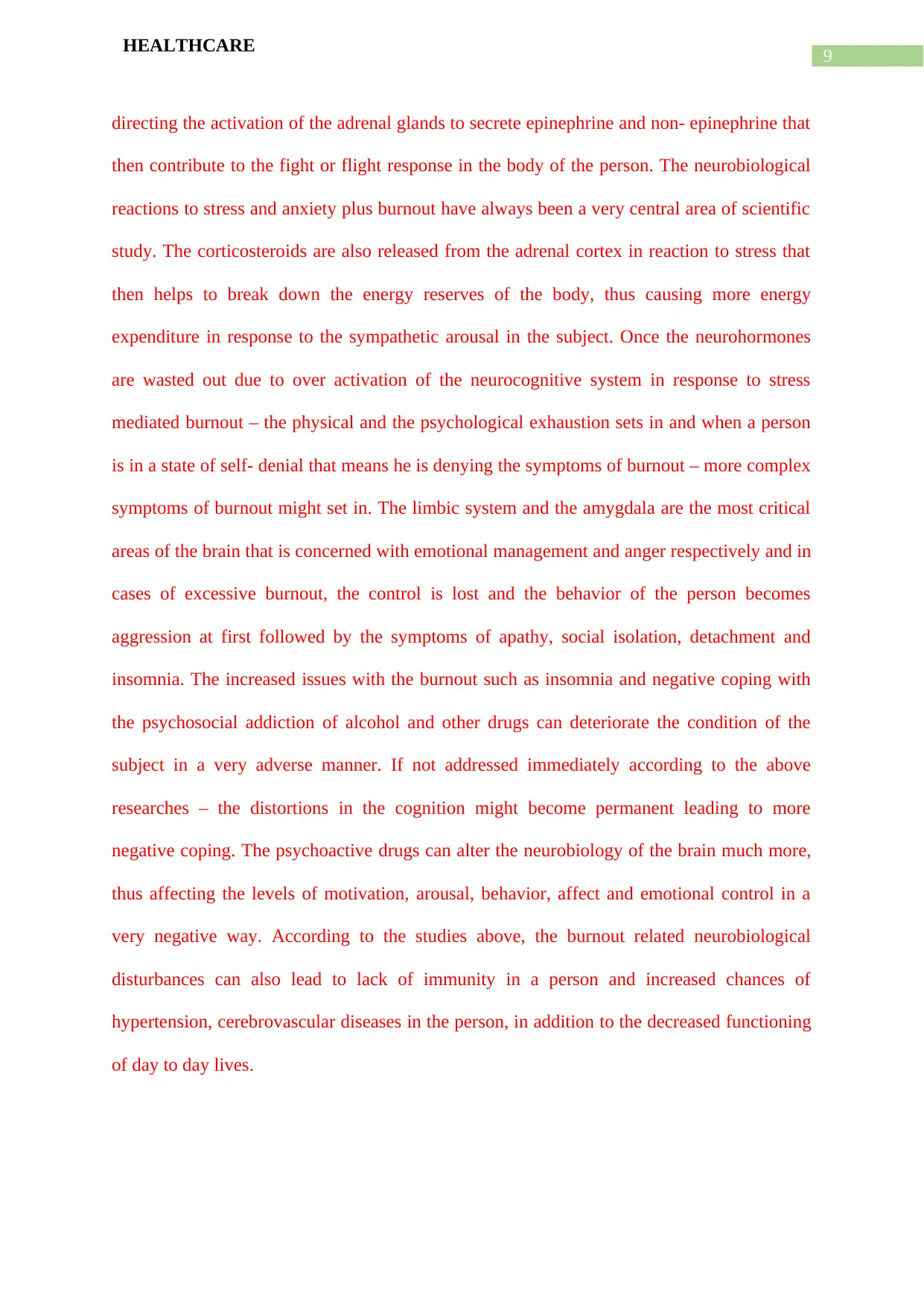
9
HEALTHCARE
directing the activation of the adrenal glands to secrete epinephrine and non- epinephrine that
then contribute to the fight or flight response in the body of the person. The neurobiological
reactions to stress and anxiety plus burnout have always been a very central area of scientific
study. The corticosteroids are also released from the adrenal cortex in reaction to stress that
then helps to break down the energy reserves of the body, thus causing more energy
expenditure in response to the sympathetic arousal in the subject. Once the neurohormones
are wasted out due to over activation of the neurocognitive system in response to stress
mediated burnout – the physical and the psychological exhaustion sets in and when a person
is in a state of self- denial that means he is denying the symptoms of burnout – more complex
symptoms of burnout might set in. The limbic system and the amygdala are the most critical
areas of the brain that is concerned with emotional management and anger respectively and in
cases of excessive burnout, the control is lost and the behavior of the person becomes
aggression at first followed by the symptoms of apathy, social isolation, detachment and
insomnia. The increased issues with the burnout such as insomnia and negative coping with
the psychosocial addiction of alcohol and other drugs can deteriorate the condition of the
subject in a very adverse manner. If not addressed immediately according to the above
researches – the distortions in the cognition might become permanent leading to more
negative coping. The psychoactive drugs can alter the neurobiology of the brain much more,
thus affecting the levels of motivation, arousal, behavior, affect and emotional control in a
very negative way. According to the studies above, the burnout related neurobiological
disturbances can also lead to lack of immunity in a person and increased chances of
hypertension, cerebrovascular diseases in the person, in addition to the decreased functioning
of day to day lives.
HEALTHCARE
directing the activation of the adrenal glands to secrete epinephrine and non- epinephrine that
then contribute to the fight or flight response in the body of the person. The neurobiological
reactions to stress and anxiety plus burnout have always been a very central area of scientific
study. The corticosteroids are also released from the adrenal cortex in reaction to stress that
then helps to break down the energy reserves of the body, thus causing more energy
expenditure in response to the sympathetic arousal in the subject. Once the neurohormones
are wasted out due to over activation of the neurocognitive system in response to stress
mediated burnout – the physical and the psychological exhaustion sets in and when a person
is in a state of self- denial that means he is denying the symptoms of burnout – more complex
symptoms of burnout might set in. The limbic system and the amygdala are the most critical
areas of the brain that is concerned with emotional management and anger respectively and in
cases of excessive burnout, the control is lost and the behavior of the person becomes
aggression at first followed by the symptoms of apathy, social isolation, detachment and
insomnia. The increased issues with the burnout such as insomnia and negative coping with
the psychosocial addiction of alcohol and other drugs can deteriorate the condition of the
subject in a very adverse manner. If not addressed immediately according to the above
researches – the distortions in the cognition might become permanent leading to more
negative coping. The psychoactive drugs can alter the neurobiology of the brain much more,
thus affecting the levels of motivation, arousal, behavior, affect and emotional control in a
very negative way. According to the studies above, the burnout related neurobiological
disturbances can also lead to lack of immunity in a person and increased chances of
hypertension, cerebrovascular diseases in the person, in addition to the decreased functioning
of day to day lives.
Paraphrase This Document
Need a fresh take? Get an instant paraphrase of this document with our AI Paraphraser
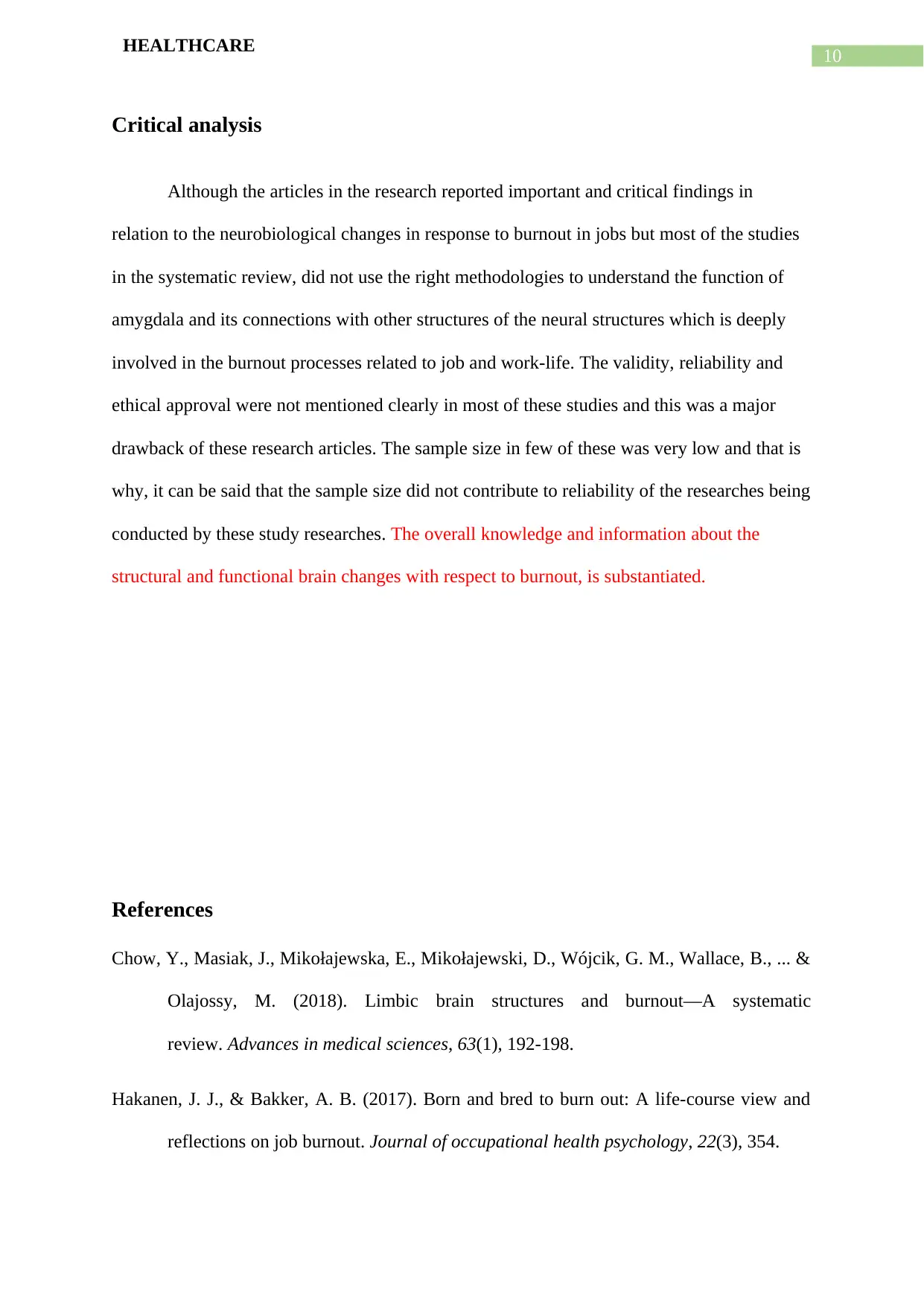
10
HEALTHCARE
Critical analysis
Although the articles in the research reported important and critical findings in
relation to the neurobiological changes in response to burnout in jobs but most of the studies
in the systematic review, did not use the right methodologies to understand the function of
amygdala and its connections with other structures of the neural structures which is deeply
involved in the burnout processes related to job and work-life. The validity, reliability and
ethical approval were not mentioned clearly in most of these studies and this was a major
drawback of these research articles. The sample size in few of these was very low and that is
why, it can be said that the sample size did not contribute to reliability of the researches being
conducted by these study researches. The overall knowledge and information about the
structural and functional brain changes with respect to burnout, is substantiated.
References
Chow, Y., Masiak, J., Mikołajewska, E., Mikołajewski, D., Wójcik, G. M., Wallace, B., ... &
Olajossy, M. (2018). Limbic brain structures and burnout—A systematic
review. Advances in medical sciences, 63(1), 192-198.
Hakanen, J. J., & Bakker, A. B. (2017). Born and bred to burn out: A life-course view and
reflections on job burnout. Journal of occupational health psychology, 22(3), 354.
HEALTHCARE
Critical analysis
Although the articles in the research reported important and critical findings in
relation to the neurobiological changes in response to burnout in jobs but most of the studies
in the systematic review, did not use the right methodologies to understand the function of
amygdala and its connections with other structures of the neural structures which is deeply
involved in the burnout processes related to job and work-life. The validity, reliability and
ethical approval were not mentioned clearly in most of these studies and this was a major
drawback of these research articles. The sample size in few of these was very low and that is
why, it can be said that the sample size did not contribute to reliability of the researches being
conducted by these study researches. The overall knowledge and information about the
structural and functional brain changes with respect to burnout, is substantiated.
References
Chow, Y., Masiak, J., Mikołajewska, E., Mikołajewski, D., Wójcik, G. M., Wallace, B., ... &
Olajossy, M. (2018). Limbic brain structures and burnout—A systematic
review. Advances in medical sciences, 63(1), 192-198.
Hakanen, J. J., & Bakker, A. B. (2017). Born and bred to burn out: A life-course view and
reflections on job burnout. Journal of occupational health psychology, 22(3), 354.
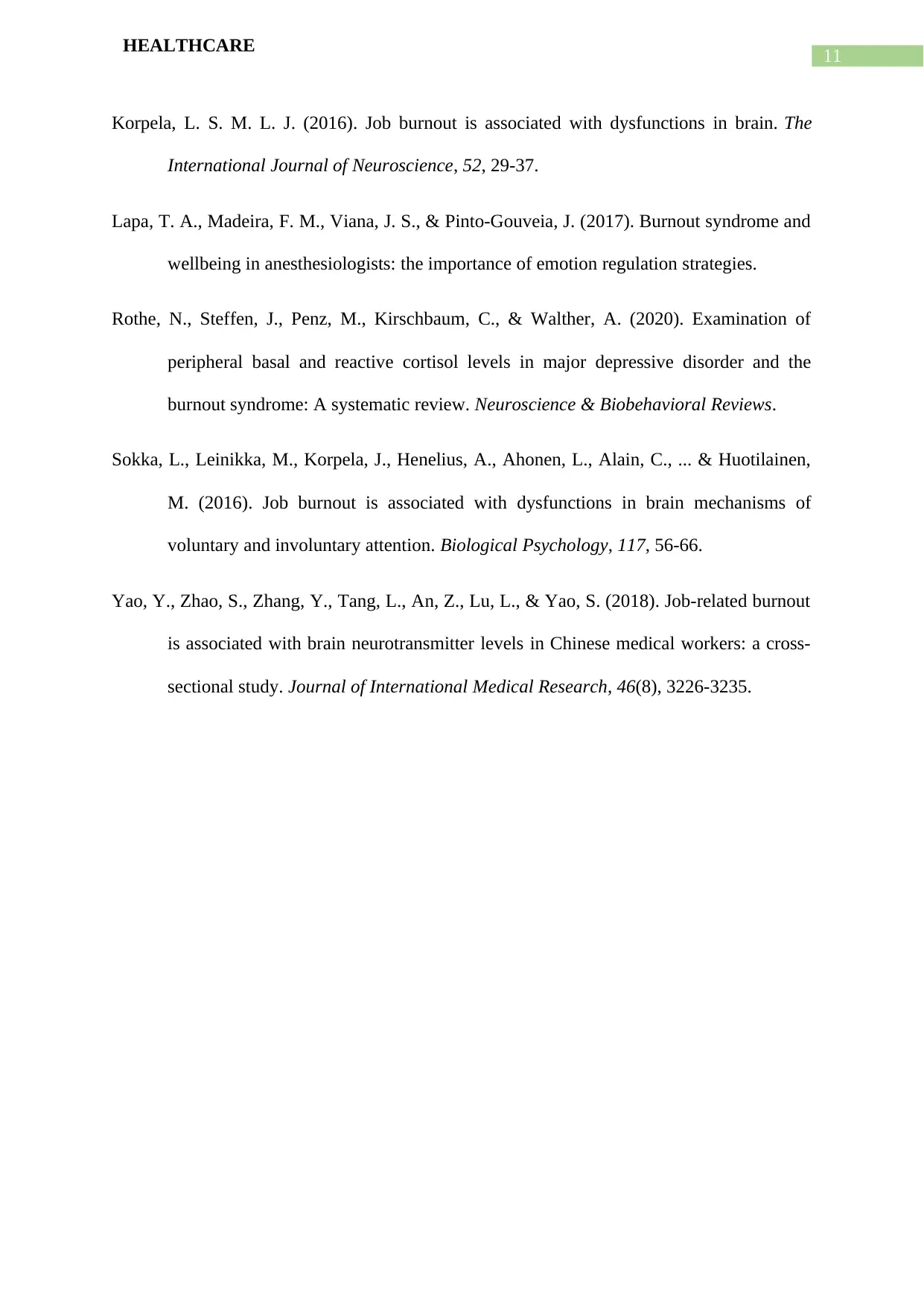
11
HEALTHCARE
Korpela, L. S. M. L. J. (2016). Job burnout is associated with dysfunctions in brain. The
International Journal of Neuroscience, 52, 29-37.
Lapa, T. A., Madeira, F. M., Viana, J. S., & Pinto-Gouveia, J. (2017). Burnout syndrome and
wellbeing in anesthesiologists: the importance of emotion regulation strategies.
Rothe, N., Steffen, J., Penz, M., Kirschbaum, C., & Walther, A. (2020). Examination of
peripheral basal and reactive cortisol levels in major depressive disorder and the
burnout syndrome: A systematic review. Neuroscience & Biobehavioral Reviews.
Sokka, L., Leinikka, M., Korpela, J., Henelius, A., Ahonen, L., Alain, C., ... & Huotilainen,
M. (2016). Job burnout is associated with dysfunctions in brain mechanisms of
voluntary and involuntary attention. Biological Psychology, 117, 56-66.
Yao, Y., Zhao, S., Zhang, Y., Tang, L., An, Z., Lu, L., & Yao, S. (2018). Job-related burnout
is associated with brain neurotransmitter levels in Chinese medical workers: a cross-
sectional study. Journal of International Medical Research, 46(8), 3226-3235.
HEALTHCARE
Korpela, L. S. M. L. J. (2016). Job burnout is associated with dysfunctions in brain. The
International Journal of Neuroscience, 52, 29-37.
Lapa, T. A., Madeira, F. M., Viana, J. S., & Pinto-Gouveia, J. (2017). Burnout syndrome and
wellbeing in anesthesiologists: the importance of emotion regulation strategies.
Rothe, N., Steffen, J., Penz, M., Kirschbaum, C., & Walther, A. (2020). Examination of
peripheral basal and reactive cortisol levels in major depressive disorder and the
burnout syndrome: A systematic review. Neuroscience & Biobehavioral Reviews.
Sokka, L., Leinikka, M., Korpela, J., Henelius, A., Ahonen, L., Alain, C., ... & Huotilainen,
M. (2016). Job burnout is associated with dysfunctions in brain mechanisms of
voluntary and involuntary attention. Biological Psychology, 117, 56-66.
Yao, Y., Zhao, S., Zhang, Y., Tang, L., An, Z., Lu, L., & Yao, S. (2018). Job-related burnout
is associated with brain neurotransmitter levels in Chinese medical workers: a cross-
sectional study. Journal of International Medical Research, 46(8), 3226-3235.
⊘ This is a preview!⊘
Do you want full access?
Subscribe today to unlock all pages.

Trusted by 1+ million students worldwide
1 out of 12
Related Documents
Your All-in-One AI-Powered Toolkit for Academic Success.
+13062052269
info@desklib.com
Available 24*7 on WhatsApp / Email
![[object Object]](/_next/static/media/star-bottom.7253800d.svg)
Unlock your academic potential
Copyright © 2020–2025 A2Z Services. All Rights Reserved. Developed and managed by ZUCOL.





